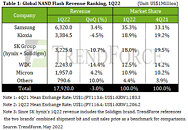
Micron Launches Industrial DDR5 Server DRAM
Micron today announced commercial and industrial channel partner availability of Micron DDR5 server DRAM in support of industry qualification of next-generation Intel and AMD DDR5 server and workstation platforms. The move to DDR5 memory enables up to an 85% increase in system performance over DDR4 DRAM. Micron's new server DDR5 memory maximizes performance for AI, HPC and data-intensive applications that require more CPU compute capacity and higher memory bandwidth than DDR4 technology can support.
"As data continues to grow exponentially, the need to derive insights from that data is critical to business success," said Teresa Kelley, vice president and general manager of Micron's Commercial Products Group. "Data center operators need to maximize platform performance with advanced memory capabilities and processor advancements. Micron DDR5 server DRAM provides unparalleled bandwidth to manage even the most memory-intensive applications. Micron has been on the forefront of the industry's transition to DDR5 memory technology and is committed to empowering data center customers and channel partners in their server DDR5 DRAM qualification and readiness efforts."
"As data continues to grow exponentially, the need to derive insights from that data is critical to business success," said Teresa Kelley, vice president and general manager of Micron's Commercial Products Group. "Data center operators need to maximize platform performance with advanced memory capabilities and processor advancements. Micron DDR5 server DRAM provides unparalleled bandwidth to manage even the most memory-intensive applications. Micron has been on the forefront of the industry's transition to DDR5 memory technology and is committed to empowering data center customers and channel partners in their server DDR5 DRAM qualification and readiness efforts."



































